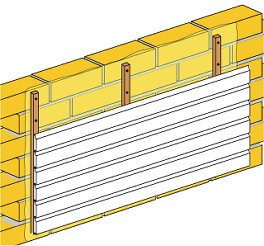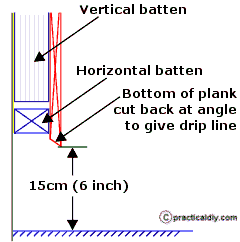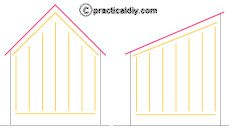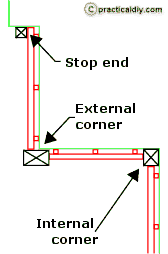How To Install Blue Board Cladding
Horizontal cladding
(weatherboard)
 This article gives very full general guidelines for applying horizontal external cladding. uPVC and fibre cement cladding materials ordinarily come up with their own instructions and include trim pieces (i.east. end sealing strips etc) specific to the manufacturer.
This article gives very full general guidelines for applying horizontal external cladding. uPVC and fibre cement cladding materials ordinarily come up with their own instructions and include trim pieces (i.east. end sealing strips etc) specific to the manufacturer.
This article is intended for the Britain utilise, other countries will probably take their own building codes which will need to be conformed to.
General guidelines
Timber building materials should never be placed in direct contact with soil or used at a level which may be flooded.
 Cladding should always cease some 15cm (6 inches) above footing level, whether it is physical or soil, this reduces the amount of muck splashed up to them from pelting hit the ground.
Cladding should always cease some 15cm (6 inches) above footing level, whether it is physical or soil, this reduces the amount of muck splashed up to them from pelting hit the ground.
The bottom of the everyman plank should ideally be cut at an angle to class a drip line along the forepart of the lowest plank (run into right)
Timber plank sizes
The different plank profiles (see this other commodity) are usually available in a choice of widths ranging from 200 to 225mm (4 to 9 inches) - the different profiles will have a different pick. The wider the planks (which as well generally ways thicker), the greater the problem with warping and twisting - 150mm (6 inch) wide planks are often considered to exist the widest preferred width.
Generally, the longer the length of cladding, the wider planks wait ameliorate (the converse is also true, the shorter the length, narrower planks expect better) - but at that place are no hard and fast rules.
Wherever possible, a single plank length should be used across the full width; joints in a horizontal run should be avoided every bit they offer a route for water to enter backside the cladding. Where planks have to abut horizontally, they must run across in the middle of a batten,
Vapour barrier membrane
Where the supporting wall is not atmospheric condition tight (i.e. timber frame) or where insulation is to be fitted backside the cladding, a vapour barrier must exist fitted to cover the wall or insulation textile.
This prevent whatever moisture which does get behind the cladding from penetrating the building structure.
In the UK, the vapour barrier membrane should comply with BS 4016.
Battens
Timber battens should be fitted vertically to the building to support the cladding, the battens should exist force per unit area treated softwood, typically of minimum size 25 x 38mm (1 x ane½ inch) - the thickness of the battens should exist at to the lowest degree 1½ times the thickness of the timber cladding to ensure they are thick plenty to take the fixings (where overlapping cladding planks are used, this means 1½ fourth dimension the thickness at the overlap).
Battens should be fixed vertically (either nailed or screwed) on height of the vapour barrier to the construction, the horizontal spacing betwixt the battens should exist no more than than 60cm (ii ft).
A horizontal batten should be stock-still just in a higher place the bottom line of the cladding to shut off the space behind the cladding - this denies entry for pests and small animals.
 Where the cladding is to exist put onto a gable end, a crossbar should be fixed parallel to, and simply in from the gable lines. In a like style with a sloping roof, a batten should be fixed parallel with the roof line.
Where the cladding is to exist put onto a gable end, a crossbar should be fixed parallel to, and simply in from the gable lines. In a like style with a sloping roof, a batten should be fixed parallel with the roof line.
As battens are being fixed, each ane should checked to ensure that the front face of all are level horizontally and vertically, small pieces of treated timber may need to be fitted behind some battens as packing to overcome irregularities in the wall. It usually helps to start past fixing the farthermost finish battens, and then using a line stretched between them to line upwardly the front faces of the remaining battens.
Side seals
In that location are three possible ways from cladding planks to end: 
- A stop, either where the cladding stops at a point where information technology abuts a return or just where the cladding stops.
- An external corner where the next cladded confront goes away backwards from the corner
- An internal corner where the next cladded face up comes forward from the corner.
Each of these is illustrated to the right; the method for 'closing' each is:
- A vertical piece of timber is used to shut off the cease of the cladding, either in front (as illustrated) where the cladding meets a return, or down the side where the cladding ends.
- At an external corner, a vertical timber should abut the end of the cladding on each side face up.
- A vertical timber should be fixed before the cladding is practical so that the cladding on each sides buts upwards to it.
Fastenings
Cladding planks can more often than not be nailed to the battens, usually there is no need to pre-drill - but pre-drilling pilot holes may be needed with hardwood cladding or for the nails near to the end of the planks to reduce the chances of the timber splitting.
Fixing nails should be at to the lowest degree 2½ fourth dimension the thickness cladding, including any overlap
Avoid using steel nails, instead use hot galvanised dipped, marine quality or other non-corrosive nails. Using annular ring nails will hold the cladding more securely but are mostly unnecessary.
Source: https://www.practicaldiy.com/general-building/external-cladding/horizontal-cladding.php
Posted by: rodriguezwitarsted.blogspot.com


0 Response to "How To Install Blue Board Cladding"
Post a Comment